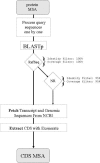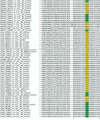PROTOGENE: turning amino acid alignments into bona fide CDS nucleotide alignments
- PMID: 16845080
- PMCID: PMC1538918
- DOI: 10.1093/nar/gkl170
PROTOGENE: turning amino acid alignments into bona fide CDS nucleotide alignments
Abstract
We describe Protogene, a server that can turn a protein multiple sequence alignment into the equivalent alignment of the original gene coding DNA. Protogene relies on a pipeline where every initial protein sequence is BLASTed against RefSeq or NR. The annotation associated with potential matches is used to identify the gene sequence. This gene sequence is then aligned with the query protein using Exonerate in order to extract a coding nucleotide sequence matching the original protein. Protogene can handle protein fragments and will return every CDS coding for a given protein, even if they occur in different genomes. Protogene is available from http://www.tcoffee.org/.
Figures



Similar articles
-
PAL2NAL: robust conversion of protein sequence alignments into the corresponding codon alignments.Nucleic Acids Res. 2006 Jul 1;34(Web Server issue):W609-12. doi: 10.1093/nar/gkl315. Nucleic Acids Res. 2006. PMID: 16845082 Free PMC article.
-
transAlign: using amino acids to facilitate the multiple alignment of protein-coding DNA sequences.BMC Bioinformatics. 2005 Jun 22;6:156. doi: 10.1186/1471-2105-6-156. BMC Bioinformatics. 2005. PMID: 15969769 Free PMC article.
-
Expresso: automatic incorporation of structural information in multiple sequence alignments using 3D-Coffee.Nucleic Acids Res. 2006 Jul 1;34(Web Server issue):W604-8. doi: 10.1093/nar/gkl092. Nucleic Acids Res. 2006. PMID: 16845081 Free PMC article.
-
NPS@: network protein sequence analysis.Trends Biochem Sci. 2000 Mar;25(3):147-50. doi: 10.1016/s0968-0004(99)01540-6. Trends Biochem Sci. 2000. PMID: 10694887 Review. No abstract available.
-
Current methods for automated annotation of protein-coding genes.Curr Opin Insect Sci. 2015 Feb;7:8-14. doi: 10.1016/j.cois.2015.02.008. Epub 2015 Mar 7. Curr Opin Insect Sci. 2015. PMID: 32846689 Review.
Cited by
-
MyHits: improvements to an interactive resource for analyzing protein sequences.Nucleic Acids Res. 2007 Jul;35(Web Server issue):W433-7. doi: 10.1093/nar/gkm352. Epub 2007 Jun 1. Nucleic Acids Res. 2007. PMID: 17545200 Free PMC article.
-
Detecting remote sequence homology in disordered proteins: discovery of conserved motifs in the N-termini of Mononegavirales phosphoproteins.PLoS One. 2012;7(3):e31719. doi: 10.1371/journal.pone.0031719. Epub 2012 Mar 5. PLoS One. 2012. PMID: 22403617 Free PMC article.
-
TranslatorX: multiple alignment of nucleotide sequences guided by amino acid translations.Nucleic Acids Res. 2010 Jul;38(Web Server issue):W7-13. doi: 10.1093/nar/gkq291. Epub 2010 Apr 30. Nucleic Acids Res. 2010. PMID: 20435676 Free PMC article.
-
Characterisation of a newly identified human rhinovirus, HRV-QPM, discovered in infants with bronchiolitis.J Clin Virol. 2007 Jun;39(2):67-75. doi: 10.1016/j.jcv.2007.03.012. Epub 2007 May 7. J Clin Virol. 2007. PMID: 17482871 Free PMC article.
-
T-Coffee: a web server for the multiple sequence alignment of protein and RNA sequences using structural information and homology extension.Nucleic Acids Res. 2011 Jul;39(Web Server issue):W13-7. doi: 10.1093/nar/gkr245. Epub 2011 May 9. Nucleic Acids Res. 2011. PMID: 21558174 Free PMC article.
References
-
- Altschul S.F., Gish W., Miller W., Myers E.W., Lipman D.J. Basic local alignment search tool. J. Mol. Biol. 1990;215:403–410. - PubMed
Publication types
MeSH terms
Substances
LinkOut - more resources
Full Text Sources

